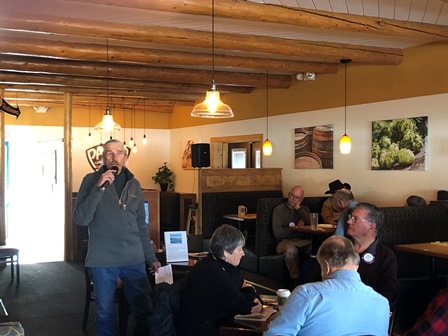
“All day I’ve faced,” the song goes, “the barren waste, without the taste of water, cool water. Old Dan and I with throats burned dry, and souls that cry for water, cool, clear water.” This more or less describes the future of not only Dan and Bob Nolan (the song writer; Dan was a mule), but of much of the southwest, as well, indicated former Water Commissioner Val Valentine.
We are currently, and since 2002, said Val, in a protracted drought, citing the low levels throughout recent years of the water stored in Lake Powell and Lake Mead, the major impoundments for water flowing from the western slope of Colorado though the Upper Basin of the Colorado River. Powell, he reported is currently 65% full, and at a water level of 3577 feet, if the lake drops another 100 feet, it will no longer be able to generate electric power that supplies users in a vast area.
But upstream reservoirs are even lower, he said, with Navajo Lake for example at 50% of full, and thus lack ability to replenish Powell. Plus, Lake Mead, downsteam of Powell and the major source of water for urban centers like Los Angeles, Phoenix and Las Vegas, is even lower, at only 40% of capacity.
Simply put, demand on the Basin is acute. For example, Val reported that if Mead lowers only 11 feet more to a water level of 1074 feet, that will shut off water supply to the Central Arizona Project, which supplies water to substantial urban areas in Arizona, including Tucson (through a 300-mile pipeline).
Snow pack is currently relatively good, Val noted. Last year the snow pack reached only 34% of normal, but this year in the Upper San Juan Basin it stands currently at 99% of normal for this time of the season. But, he added, it is no time to breathe a sigh of relief: the current volume of water in the snowpack equals 19.1 inches, whereas the historical norm on the First of April should be 34.7 inches, so there is a long way to go.
Val compared the present to what he called a “mega-drought” in the 12th Century, which he reported has been shown by research to have been a likely cause of the relocation in that era of Native Americans from scattered settlements to pueblos.
The history, Val stated is that we don’t have enough water. So the question is, how do we use what we do have. The state’s answer is the Colorado Water Plan, which includes an assumption that Colorado’s population will double by 2050.
He reported even despite drought conditions, Colorado has continued to meet obligations under its 1922 compact with California, Arizona, Nevada, New Mexico, Utah and Wyoming for downstream water delivery.
But that is not enough, Val explained. The state’s plan for the future sketched in the Water Plan includes demanding components: creating new supplies by building infrastructure to improve efficiency such as new reservoirs, municipal conservation (Pagosa Area Water and Sanitary Distirct has made considerable headway he reported, having reduced average local consumption by nearly 20%), and acquisition of new water rights for population centers from state agricultural users.
Val didn’t mention the possibility of resorting to rain dances. But I guess that didn’t work in the 12th Century, so it probably won’t work now, either.
 Pagosa Springs Rotary Club
Pagosa Springs Rotary Club